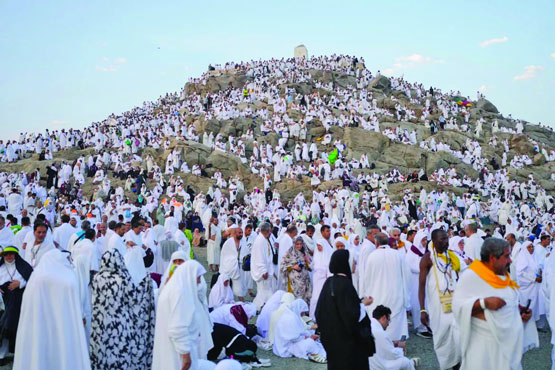Hajj pilgrims converge and pray at Mount Arafat
Industry Desk: More than 1.5 million Muslims braved extreme heat to reach Mount Arafat on Saturday, marking the high point of the annual hajj pilgrimage. Pilgrims prayed for hours, especially for Palestinians in war-ravaged Gaza, reports agencies.
Clad in white, worshippers began arriving at dawn for the most grueling day of the pilgrimage, ascending the rocky 70-meter (230-foot) hill where the Prophet Mohammed is believed to have delivered his final sermon.
“This is the most important day,” said 46-year-old Egyptian Mohammed Asser, who brought a list of prayers. “I also pray for the Palestinians. May God help them.” This year’s hajj takes place against the backdrop of the war in Gaza between Israel and Hamas, which began after Palestinian militants launched an unprecedented attack on southern Israel on October 7. The assault resulted in the deaths of 1,194 people, mostly civilians, according to official Israeli figures. Israel’s retaliatory offensive has killed at least 37,266 people in Gaza, mostly civilians, according to the Hamas-controlled health ministry.
Saudi Arabia’s minister in charge of religious pilgrimages, Tawfiq al-Rabiah, warned last week that “no political activity” would be tolerated during the hajj. However, at least one pilgrim was heard chanting in support of the Palestinians who have endured months of bombardment. “Pray for our brothers in Palestine, in Gaza… may God give victory to the Muslims,” he shouted.
In a message to hajj pilgrims, Iranian Supreme Leader Ayatollah Ali Khamenei expressed support for the Palestinians, stating, “The ironclad resistance of Palestine and the patient, oppressed people of Gaza… must be fully supported in every way.”
Approximately 2,000 Palestinians are performing the hajj at the special invitation of Saudi King Salman, according to official media.
The hajj, one of the world’s largest religious gatherings, is increasingly affected by climate change. A Saudi study published last month noted that regional temperatures are rising by 0.4 degrees Celsius each decade.
The rituals, which span at least five days and are mostly outdoors, are challenging due to the intense heat. “It’s not easy because it is very hot,” said 26-year-old Abraman Hawa from Ghana. “We have sun, but it is not as hot. I will pray to Allah at Arafat because I need his support,” she added.
Temperatures were expected to hit 43 degrees Celsius (109.4 degrees Fahrenheit) on Saturday, creating challenges for pilgrims who arrived at Mount Arafat after spending the night in a giant tented city in Mina, a valley outside Mecca. Saudi authorities urged pilgrims to drink plenty of water and protect themselves from the sun. Since men are prohibited from wearing hats, many carried umbrellas.
More than 10,000 heat-related illnesses were recorded last year, 10 percent of them heat strokes, according to a Saudi official. Ahmad Karim Abdelsalam, a 33-year-old pilgrim from India, admitted that he found the prospect of passing hours on Mount Arafat “a little scary.” However, with an umbrella and water sprays, he said, “God willing, everything will go well.”
The hajj is one of the five pillars of Islam, and all Muslims with the means must perform it at least once in their lives. However, obtaining visas, which are distributed on a quota system, can be challenging.
“It’s a chance that only comes once in a lifetime. I couldn’t not come,” said Abdulrahman Siyam, a 55-year-old Iraqi pilgrim performing the rituals on a prosthetic leg.
After Mount Arafat, the pilgrims will head to Muzdalifah to collect pebbles for the symbolic “stoning of the devil” ritual in Mina on Sunday. At Muzdalifah, they will spend the night under the open sky.
The pilgrimage concludes with three days in Mina, coinciding with the Eid al-Adha holiday, when Muslims worldwide slaughter livestock and distribute the meat to the poor. Pilgrims then return to Mecca for a final circumambulation, known as the Farewell Tawaf.
Saudi authorities have made significant efforts to improve access and prevent accidents. Tens of thousands of security personnel are deployed across the city, especially around the holy sites, and a high-speed rail link has been built to ferry pilgrims between sites. Special electronic gates manage the flow of pilgrims.
Saudi authorities have also expanded and renovated the Grand Mosque, where cranes are seen around some of its seven minarets due to ongoing construction.
The hajj follows the path of the Prophet Mohammed’s final pilgrimage, approximately 1,400 years ago. It is a vital source of legitimacy for the Al Saud dynasty, whose monarch holds the title “Custodian of the Two Holy Mosques,” in Mecca and Medina. It is also a significant financial boon for Saudi Arabia, which is developing religious tourism to diversify its economy away from oil dependency.
Last year, the kingdom hosted more than 1.8 million hajj pilgrims, 90 percent of whom came from abroad. Additionally, 13.5 million Muslims performed umrah, the pilgrimage that can be undertaken year-round, with a goal of reaching 30 million pilgrims by 2030.
Rare Israeli airstrike in Beirut kills Hezbollah commander and more than a dozen others
International Desk: Israel launched a rare airstrike that killed a senior Hezbollah milita…








